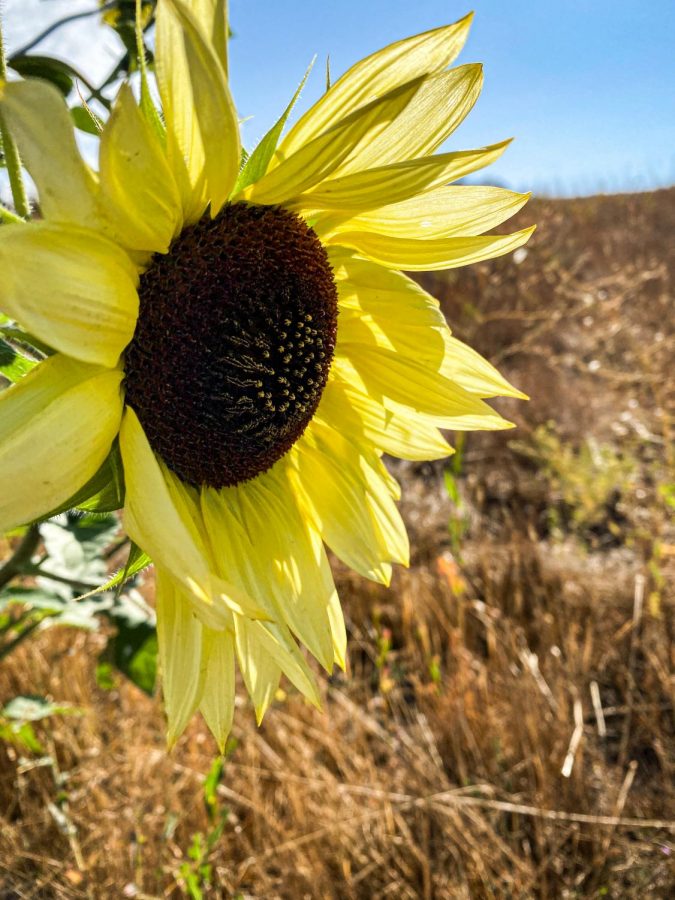Autumn adventure: Visit WSU Arboretum
Celebrate arrival of autumn; different animals can be seen at arboretum different parts of year
Hikers can see sunflowers at the arboretum.
September 30, 2021
As the days shorten and the leaves dry, there’s no better pastime than taking a stroll through the WSU Arboretum, which is right on campus.
When I visited the arboretum, I stayed for about 90 minutes. Keep in mind that I was taking my time, pausing to look at birds and other curiosities. Including travel time, 2 hours will be plenty, even if you pack lunch or snacks.
I recommend taking water, a sweatshirt, hat, sunglasses and some binoculars. The only thing you can’t bring is a dog. They’re banned to minimize disturbances to wildlife.
On the way, you’ll pass the WSU Bear Center – don’t worry, you can visit them on the way home! Right after the Bear Center, there’ll be an unmarked gravel lot on your left. That’s your turn! I suggest arriving sooner rather than later; the earlier it is, the better chances you have of seeing wildlife.
After you arrive at your humbly marked destination, take a moment to decide which trail you’d like to start on. The trail at the far left end of the parking lot takes you straight into a little thicket of deciduous trees and bushes. The trail at the right end of the parking lot takes you over the open grasslands of the arboretum.
I started in the thicket. All the trails are beautifully maintained. You don’t have to worry about bushes smacking you in the face or rocks and roots tripping you up.
The thicket was full of a sweet, musky aroma; it was as if you could smell the leaves changing color. Just a couple minutes in, I was fortunate enough to behold a spectacular great horned owl. It had been heckled out of its roost by magpies.
There are a few benches scattered throughout the arboretum. One is in the thicket, and there’s another facing the pond. Follow pretty much any trail out of the thicket, and you’ll wind up at the pond.
My tips for spotting birds and other wildlife are simple. Be quiet and be on high alert. Do a lot more listening than speaking. Take a few steps, and then stop and examine everything around you: the sky, the treetops, the middle of the canopy, the low brush and the ground.
Human eyes are designed to spot movement before anything else, so use that to your advantage. Stand still and simply watch. You’ll be amazed how much you see.
Step softly as you approach the pond’s edge. Often there will be ducks and great blue herons foraging, but they are easily spooked. Scan the treetops surrounding the pond for perching red-tailed hawks.
Next, wander onto the gravel paths that snake up the rolling hill of the arboretum. These pathways look bland, but there are quite a few critters if you know where to look.
Turn your eyes to the sky to see soaring hawks. Watch the path ahead of you to spot sparrows fluttering in the grasses. Catch a glimpse of songbirds flitting about in the patches of violet wild aster and honeybees gathering the season’s last drops of nectar.
And now, as you crest the hill, take in the views of Pullman. From here, you can see bits of campus, downtown Pullman and the golf course. You can also see the grizzlies at the Bear Center and deer at the Steffen Center.
Well, you’ve made it. End your loop by meandering back down the trail towards the parking lot. Along the way, visit the brilliantly blooming patch of sunflowers that are truly giving it their all before fall.
When you leave, note that mother nature is a fluid creature, changing her stage and actors every few weeks. Migration season is at its peak, and many bird species will use the pond as a pit stop during the fall. Remember, the arboretum looks completely different in each season, so it’s always a unique experience.


















